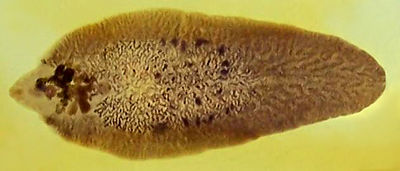Fasciola hepatica
| Also known as: | Liver Fluke |
Introduction
Fasciola Hepatica is an hepatic parasite found in mainly in ruminants, namely cows, sheep and goats, but also known to affect horses and pigs. It is found Worldwide, and within the UK, with its prevalence ever increasing. It is responsible for a 10-15% production loss in each infected animal, as it affects meat, milk and wool production, so is of huge economic consequence.
Fasiola Hepatica has a definitive ruminant mammalian host and an intermediate molluscian host. Within Europe the intermediate host is almost exclusively the snail 'Lymnaea truncatulata'. The snail habitat is crucial to the survival of the parasite, so wet conditions are favourable to the development and spread of Fasciola hepatica
Scientific Classification
| Kingdom | Animalia |
| Phylum | Platyhelminthes |
| Class | Trematoda |
| Subclass | Digenea |
| Order | Echinostomida |
| Family | Fasciolidae |
| Genus | Fasciola |
| Species | F. Hepatica |
Pathogenesis
The severity of the infection is mainly dependent on the number of metacercariae ingested. The Pathogenesis is often described as two-fold. The first stage occuring when the parasite migrates through the liver parenchyma, causing liver damage and haemorrhage. The second phase occurs when the parasite is in the bile ducts, and damage is a result of the haematophagic activity of the adult flukes.
Hosts
Fasciola hepatica has an indirect life cycle, meaning it has both intermediate and final hosts.
Fasciola hepatica is seen most commonly in sheep, cattle, and goats, but may also be seen in horse, deer, and man.
The most important intermediate host within Europe is the snail of the genus Lymnaea. The most common, Lymnaea truncatula, which is an amphibious snail found worldwide.
Life Cycle
Adult flukes in the bile ducts shed eggs directly into the ile, which then subsequently enter the intestine. Eggs are then passes out in the faeces of the mammalian host, where they develop anf hatch releasing motile ciliated miracidia. These require 9-10 dyas at optimal temperatures, of around 22-26 degrees. The miracidium have a short life and must locate a suitable snail, the intermediate host, within approximately 3 hours if they are to be effective and continue the life cycle.
References
Taylor, M.A, Coop, R.L., Wall,R.L. (2007) Veterinary Parasitology Blackwell Publishing
G.L. Pritchard et al., Emergence of fasciolosis in cattle in East Anglia, The Veterinary Record, Novemeber 5, 2005.
